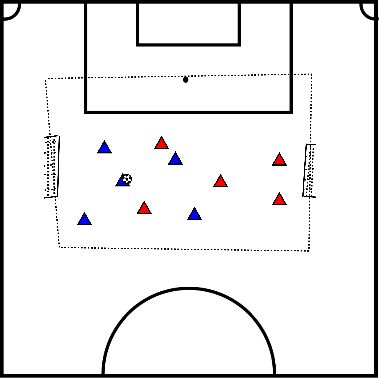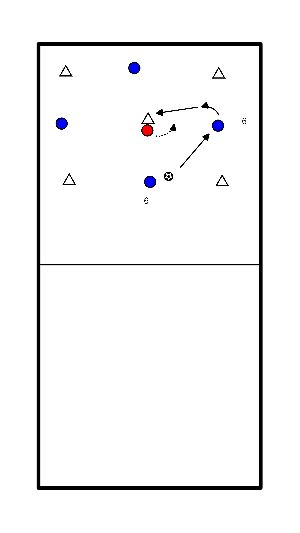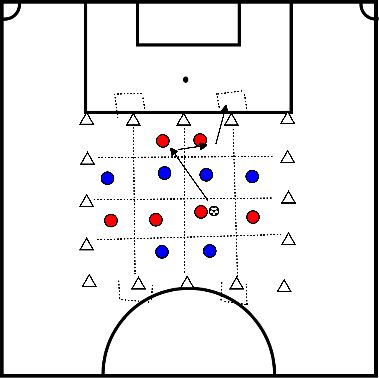Soccer drills
- The players try, dribbling with a ball, to dribble from their pawn to the middle square (the pond) and back.
- The player(s) in the box (crocodile) tries to keep the ball out of the box (pond) by picking it up or tapping it away. If the ball is touched, first go back to the pawn where you started.
- If the player succeeds in returning to the box without the ball being touched by the crocodile, he may place a hat on his pawn. The player who is the first to have five hats on his pawn is the winner.
Size: depending on age and skill.
Length: 30 metres.
Width: 20 metres.
- All players start with a ball and dribble through the box.
- The players try to keep the ball inside the box and not collide with each other.
Size: depending on age and skill.
Length: 20-25 metres.
Width: 15-20 metres.
Attacking: Score goals.
- Dribble through the box (“try to keep the ball close to youâ€).
- Try to dribble where there are no other players.
- Stay active.
- All players start with a ball, except the defender. The defender tries to take or knock balls away from the other players.
- The defender counts how many balls he has taken or tapped away. After a certain time, the defender will be changed.
Size: depending on age and skill.
Length: 20-25 meter.
Width: 15-20 meters.
Attacking:
Score goals.
- Dribble through the box.
- Staying active.
Defence:
Preventing goals and conquering the ball.
- Take away the ball.
- Staying active.
- All players start with a ball and dribble through the box.
- The players try to keep the ball inside the box and not collide with each other.
Size: depending on age and skill.
- Length: 20-25 metres.
- Width: 15-20 metres.
Material:
• Every player one
Attacking: Scoring goals.
- Dribble through the box (try to keep the ball close to you).
- Try to dribble where there are no other players.
- Stay active.
- Half of the players start with a ball, the other players try to conquer the balls.
- The players who lose a ball, try to conquer another one.
Size: depending on age and skill.
Length: 20-25 meters.
Width: 15-20 meters.
Attacking:
Score goals.
- Dribble through the box.
- Staying active.
Defence:
Preventing goals and conquering the ball.
- Take away the ball.
- Staying active.
- All players start with a ball and dribble through the box.
- The players try to keep the ball inside the box and not collide with each other.
- The players with the ball can score points by dribbling through the small goals, not being allowed to dribble through the same small goal twice in a row.
depending on age and ability.
Length: 20-25 metres.
Width: 15-20 metres.
Goal Scoring.
- Dribble through the box (“try to keep the ball close to youâ€).
- Try to dribble where there are no other players.
- Stay active.
- All players start with a ball and dribble through the box. The defender tries to take or knock balls away from the other players.
- The defender counts how many balls he has taken or tapped away. After a certain time, the defenders are changed.
- The players with the ball can score points by dribbling through the small goals. They are not allowed to dribble through the same small goal twice.
Size: depending on age and ability.
Length: 20-25 metres.
Width: 15-20 metres.
Goal Scoring.
- Dribble through the box (“try to keep the ball close to youâ€).
- Try to dribble where there are no other players.
- Keep participating actively.
- All players start with a ball and dribble through the box.
- The players try to keep the ball inside the box and not collide with each other.
Size: depending on age and ability.
Length: 20-25 metres.
Width: 15-20 metres.
Attacking: Score goals.
- Dribble through the box (“try to keep the ball close to youâ€).
- Try to dribble where there are no other players.
- Stay active.
In pairs:
- Circle around field.
- Ball out of goal, dribble to center,
- Balancing exercise
- Dribble back to the goal
- Half circle around the field
- Wheelbarrow
- Return on your back
- Half round field
- Ordinary rules of the game (match alike)
- Check that what has been learnt is understood and applied in a game
- Scoring in the small goal must be done with the foot. = 1 point
- Scoring in the big goal with the head = 2 points
- Has the objective been achieved?
- To see the relationship between the solutions/possibilities offered in the previous exercise forms and the party form (competition)

Team task:
Structure
Purpose:
Improve assumption to "move" opponent
Organisation:
- Positioning game 3/4x1 in square box of 6x6.
- pawn in the middle, team ball-possession must shoot this pawn for points, defender must prevent this.
- Each player in team ball-possession is on one side of the square.
- A player may only defend by intercepting a pass on a pawn.
- Match/fun element can be reinforced by agreeing that the person with the most points has won after 5 minutes, the rest must for example do 10 push-ups or sprints.
- Can be made more difficult by the fact that attacking party has to score in 10 passes.
Coaching:
Direction in assumption to "move" opponent, freeing up space to play towards pawn.
1.5 metres:
- Because the defender is only allowed to intercept passes, there are no duels.
- Furthermore, perimeter ensures that players in team ball-possession do not come closer than 1.5 metres.
- the shape also invites players to keep the pitch as large as possible.

Team task:
Building up
Purpose:
Improve deep play at the right moment.
Organisation:
- Field of e.g. 30x30,
- Divided into 16 compartments.
- On the 2 sides
- 2 goals.
- 2 teams of 6.
- 2 players per team are divided over 4 boxes at the back,
- 4 players all have their own square.
- There is a box with defenders between the two parts of the team.
- Four must reach the duos, the duos can score in goals (see picture).
- More difficult:
- A maximum of 10 passes.
- See picture.
- 1.5 metres: boxes prevent players from duelling with each other or getting close to each other.









